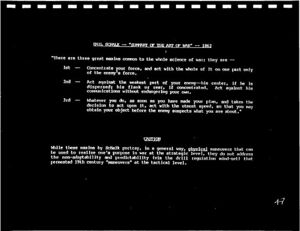Patterns of Conflict
| The works of |
| Works of John Boyd |
|---|
OODA WIKI Edition
Quantico Transcription
Boyd: Okay, here is another theorist at the time. What he did, he said he was deeply influenced by Jomini. Emil Schalk, note what he wrote in 1862 during the Civil War. He said, “there are three great maxims common to the whole science of war.” And they’re not unfamiliar, you’ve seen them before. And of course, I added a little cautionary note here at the bottom. That’s my cautionary note. Two things: while these maxims by Schalk portray in a general way, note I underline physical maneuver. You only bring out the physical, not the moral and mental. That’s why I underlined that. That can be used to realize— Also, they do not address the non-adaptability and predictability of the drill regulation mindset that permeated the 19th century.
“Maneuvers” at the tactical level. I put quotes around “maneuvers” because they didn’t look much like maneuvers, since they were rather rigid. There are some interesting books about that at this time. In fact, there’s a book— anybody ever read Forward into Battle?[1] There’s another book— I’m trying to remember the name of it now. The one that two guys wrote about the southern [unintelligible].
Audience: Oh, McWhiney and Jamieson[2]—
Boyd: What’s the name of that?
Audience: Attack and Die—
Boyd: You want to read that very carefully. There are some interesting things in there. They’ve got a lot of quotes. There are a couple cases in there where a so-called attack broke down. Note the words. They really didn’t break down, but they lost all their goddamn uniformity and rigidity, and the goddamn guys floated at the enemy line every which way and they won. They sat there mystified. How did that happen? Then they went back to their old ways again, tried to pound it home and they couldn’t. Some of the ones were breaking—what they thought were breaking down were actually succeeding. What they didn’t realize was the ambiguity and deception, guys couldn’t deal with the fluidity. So they focused on the wrong thing.
Not only that, Jomini had the answer and refused the answer. You want to read Jomini’s book, The Art of War, where he was talking about cavalry. What he’s doing, he juxtaposes the Cossacks versus the French cavalry. He talks about it and he says, “They seemed to operate in irregular fashion. You don’t know how they’re operating but they seem to have a common purpose,” and he makes a comment upon the fact that Lloyd, who preceded him, saw that really the Cossacks were a better cavalry than all the other cavalries because of this. Then Jomini looks at this. He said he agreed with him, he said, “but however, we all know the regular cavalry is better,” so he voted against the evidence. He had all the evidence and voted the other way. He said, “We’re going to have these guys in nice neat formations.”
So here these other guys had the evidence where these guys are floating in and infiltrating the lines because the attack broke down. [25:00]“This is bullshit. We’re going back the other way” and blow everybody away. You want to read Forward into Battle. It’s in there. I read it. I said, “God, they don’t even read their own reports.” It was right there, right in front of their eyes.
Couldn’t see it because they had preconceptions, presuppositions in their mind, those goddamned drill regulations. They said the attack broke down, but it succeeded. The attack didn’t break down, because it did succeed. Their formations broke down and because their formations broke
down, it did succeed. That was the answer. The attack didn’t break down. The formations broke down. Because they broke down, they were able to succeed. Incorrect interpretation. You saw those. Remember that, Mike, we saw here? Geez, here it is, plain as day. They’re quoting right out of it. Boy, this is beautiful stuff.
Lightfoot Transcription
- ↑ 18 Paddy Griffith, ''Forward into Battle: Fighting Tactics from Waterloo to the Near Future,'' 2nd ed.(New York, NY: Presidio Press, 1991).
- ↑ 19 Grady McWhiney and Perry D. Jamieson, ''Attack and Die: Civil War Military Tactics and the Southern Heritage'' (Tuscaloosa, AL: University of Alabama Press, 1984).
